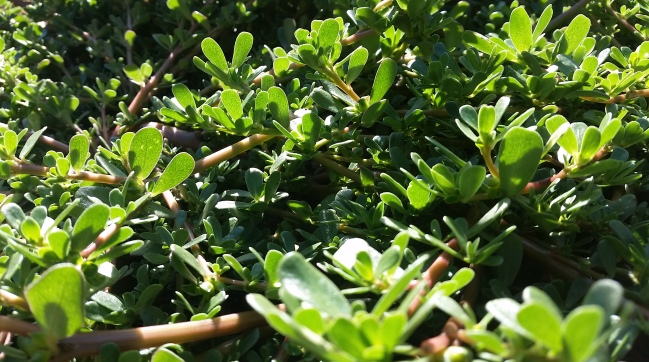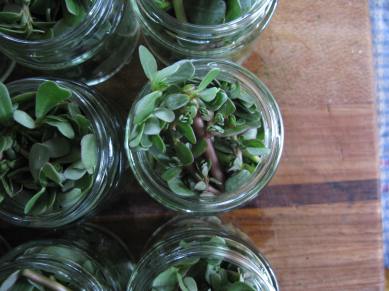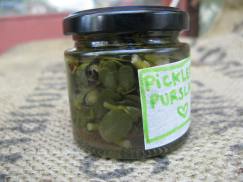
Purslane (Portulaca oleracea), also known as pigweed (not to be confused with pigface, Carpobrotus rossii) is an annual plant that grows like a ground cover. The stems and leaves are succulent-like and produce a clear juice when squeezed. It is very easy to find in Adelaide and in fact it is naturalized almost everywhere in the world.

What is a weed?
When we asked one of the most knowledgeable herbalist of Australia what was her definition of weed she answered “A weed is a plant whose use has been forgotten or yet to be discovered”. This made us reflect on how many incredibly useful plants grow around us whose value we don’ t recognize until it is revealed to us. Purslane is definitely one of these plants. Highly revered in Mediterranean and Eastern cuisine (Italian insalata di misticanza, French bonne famme soup, Lebanese fattoush just to mention a few dishes) it is almost unknown to the Australian palate.
So let’s discover some of the qualities of this incredible plant that in this season is popping up everywhere without requiring any gardening effort and in fact grows extremely well under any condition (sun or shade, rich or poor soil, watered or not).
What is a superfood?
At Wagtail farm we believe that “superfood” is a very clever marketing invention to make people believe that some very expensive food from the other side of the planet has miraculous properties that you really cannot do without. In our opinion any food grown in a rich soil, in a way that is natural and respectful to the planet, and consumed fresh and locally is a superfood. If it is wild harvested, even better. Veggies from your garden, fruit from your neighbor’s tree, herbs and berries collected in the bush, “weeds” harvested from safe collecting areas: these are the real superfoods, connecting you to the land you stand on and nourishing your body with the local nutrients tailored to the climate and conditions you live in!
Is purslane a superfood? Absolutely! And it won’t cost you a single penny!

Medicinal benefits
- The Latin name portulaca derives from the terms ‘potare’, to carry and ‘lac’, milk and in fact the plant is know and used by nursing mothers for its ability to increase milk production. A good memory trick to remember this is to think about the shape of the leaves, which can resemble a woman’s breast;
- It has a high content of vitamin C;
- The most rewarded characteristic of this plant is its high content in omega-3, one of the essential fatty acids that our bodies need to function properly. In specific, purslane contain a good amount of alpha-linolenic acid which helps to lower cholesterol, regulate blood pressure and metabolism and protect against bladder, breast, lung and prostate cancer and melanomas;
- It’s rich in iron and magnesium and therefore helps to nourish the spinal cord, the nerves and the brain fibers promoting memory, concentration and muscle function.
Culinary uses
Purslane can be eaten raw or cooked and is very adaptable to any dish that calls for greens. It is very common to have it in a salad, usually in combination with onion, chives or freshly grounded pepper to counteract the cooling effect of the plant. It is good in sandwiches, stir-fries, omelettes, soups and pickles.

It can be eaten freely, however it does contain a reasonable amount of oxalic acid (about the same amount as spinach); the younger the leaves the lower the content. If this worries you, keep in mind that a high oxalic acid intake is not a problem as long as it is combined with foods rich in calcium (vegetables, greens and dairy) and daily exposure to sunshine for vitamin D synthesis (for further references on oxalic acid see How can I use herbs in my daily life by Isabell Shipard, highly recommended book to have in your collection).
Purslane seeds
Early settles mention Australian Aboriginals collecting purslane seeds and grinding them into a flour that they would then cook into small cakes in hot ashes. Botanist Joseph Maiden wrote in 1889 “One would suppose that so small a seed would scarcely repay the labour of collecting” but “ the natives get in splendid condition on it”.
A patch of about a square meter will produce a heaped tablespoon of oily, highly nutritious seeds, which flavour has been compared to the one of linseed.
Pickled purslane recipe
1 cup of white vinegar
vinegar
1 TBS of sugar
½ TBS of salt
herbs and spices (bay leaves, fennel seeds, mustard seeds, nigella seeds…)
freshly picked purslane stems and leaves

Rinse the purslane, cut it in small sections and place it in sterilized jars. In the meantime bring the vinegar with all the other ingredients to a boil and let simmer for 10 minutes. Pour the pickling solution over the purslane and fill the jars to the top. Close the jars and let cool down upside-down. Wait at least a month before consuming.
So please, don’t call this amazing plant a weed but enjoy the health benefits of such an incredibly adaptable “superfood”.

I think that stuff grows in our garden so will try to get up the courage to try it.
Can I eat it fresh? Cheers Amanda
Yes, you can eat it fresh! The younger leaves are milder and softer. The older leaves and thicker stems are very good for pickles.
hey just wondering are there any poisonous plants that look like purslane
Yes definately the younger the better leaves as can be bitter otherwise. I’d like to try them pickled. I think it was used a lot during the war as a winter green.
Pingback: Purslane: “weed” or “superfood”? – Weed Today
What does it taste like?